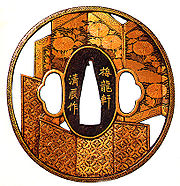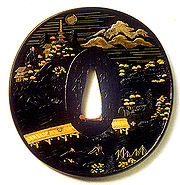
Shoami
Encyclopedia

Japan
Japan is an island nation in East Asia. Located in the Pacific Ocean, it lies to the east of the Sea of Japan, China, North Korea, South Korea and Russia, stretching from the Sea of Okhotsk in the north to the East China Sea and Taiwan in the south...
ese sword (uchi-gatana or just katana
Katana
A Japanese sword, or , is one of the traditional bladed weapons of Japan. There are several types of Japanese swords, according to size, field of application and method of manufacture.-Description:...
). The sword-guard is one of the most important symbols of the samurai
Samurai
is the term for the military nobility of pre-industrial Japan. According to translator William Scott Wilson: "In Chinese, the character 侍 was originally a verb meaning to wait upon or accompany a person in the upper ranks of society, and this is also true of the original term in Japanese, saburau...
.
Etymology

The "ami" part of this name, which derives from the name of the Amida Buddha
Buddhahood
In Buddhism, buddhahood is the state of perfect enlightenment attained by a buddha .In Buddhism, the term buddha usually refers to one who has become enlightened...
, was once used to indicate a rank among priests of a branch of Buddhism
Buddhism
Buddhism is a religion and philosophy encompassing a variety of traditions, beliefs and practices, largely based on teachings attributed to Siddhartha Gautama, commonly known as the Buddha . The Buddha lived and taught in the northeastern Indian subcontinent some time between the 6th and 4th...
called Jishu. Later, after the founding of the Ashikaga shogunate, a number of men engaged in serving the shogunal house in artistic or technical capacities included this word in their names.
The demand

Samurai
is the term for the military nobility of pre-industrial Japan. According to translator William Scott Wilson: "In Chinese, the character 侍 was originally a verb meaning to wait upon or accompany a person in the upper ranks of society, and this is also true of the original term in Japanese, saburau...
of high standing began to use the uchi-gatana; and as a result, outstanding guards for these weapons came into demand. Possibly the elevation of the status of the silver-smith to a position where he was entitled to use a name like Shoami dates from the time when craftsmen began producing fine sword guards of this kind. Naturally, as the popularity of the uchi-gatana increased, so did orders for them and for their guards. This in turn increased the number of people desiring to master the technique of guard design and production, since this field of endeavor promised prestige and reward. Apprentices to sword-guard makers must have grown in numbers, and probably feudal lords outside the capital invited these men to work for them.
Popularity
From the Muromachi period until the nineteenth-century edict prohibiting the carrying of swords, Shoami guards in a wide range of styles were being produced all over JapanJapan
Japan is an island nation in East Asia. Located in the Pacific Ocean, it lies to the east of the Sea of Japan, China, North Korea, South Korea and Russia, stretching from the Sea of Okhotsk in the north to the East China Sea and Taiwan in the south...
. In fact, so numerous are the types of Shoami guards that it is even considered safe by some people to call anything unassignable to another group Shoami. Furthermore, although some Shoami guards produced for specific clients are of high quality, they were made in quantity to be treated as merchandise and sold as souvenirs of the capital city; and there is a tendency to regard Shoami guards generally as inferior.
Influence
Shoami guards had great influence on other schools of design and production. For example, Higo guards (produced in Higo ProvinceHigo Province
Higo Province was an old province of Japan in the area that is today Kumamoto Prefecture on the island of Kyūshū. It was sometimes called , with Hizen Province. Higo bordered on Chikugo, Bungo, Hyūga, Ōsumi, and Satsuma Provinces....
), often called "the flower of sword guards," are closely connected with Shoami works. Such famous guard makers as Hirata Hikozo, Nishigaki Kanshiro, and Shimizu Jingo were trained in the Shoami style, and the Shoami influence is great in the works of Hayashi Matashichi and Miyamoto Musashi
Miyamoto Musashi
, also known as Shinmen Takezō, Miyamoto Bennosuke or, by his Buddhist name, Niten Dōraku, was a Japanese swordsman and rōnin. Musashi, as he was often simply known, became renowned through stories of his excellent swordsmanship in numerous duels, even from a very young age...
. Moreover a large number of Shoami sword guards easily pass as products of the more highly regarded Higo, Kanayama, and Owari groups. For these reasons, Shoami guards deserve proper evaluation for their powerful influence and for their intrinsic merit as objects worthy of appreciation.
Aesthetics
The characteristic of the Shoami design is abundant movement with symmetry. The seppa-dai and the hitsu-ana for the kozuka and kogai are wide, giving the guards a slightly heavy appearance. Truly outstanding Shoami open-work guards are limited to KyotoKyoto
is a city in the central part of the island of Honshū, Japan. It has a population close to 1.5 million. Formerly the imperial capital of Japan, it is now the capital of Kyoto Prefecture, as well as a major part of the Osaka-Kobe-Kyoto metropolitan area.-History:...
Shoami, and even among these the most valued are the Ko-Shoami, or old Shoami, from the Muromachi and Azuchi-Momoyama period
Azuchi-Momoyama period
The came at the end of the Warring States Period in Japan, when the political unification that preceded the establishment of the Tokugawa shogunate took place. It spans the years from approximately 1573 to 1603, during which time Oda Nobunaga and his successor, Toyotomi Hideyoshi, imposed order...
s. Muro-machi-period Ko-Shoami guards have a style that falls between those of Kyo-sukashi and Owari. Those of the Momoyama period have elements in common with the style of Nishigaki of the Higo group.
See also
- katanaKatanaA Japanese sword, or , is one of the traditional bladed weapons of Japan. There are several types of Japanese swords, according to size, field of application and method of manufacture.-Description:...
- UmetadaUmetadaUmetada is said to have been used by silversmiths since the Muromachi period. But in the Momoyama period, a certain Umetada Myoju emerged to become the founder of the manufacture of so-called "new swords," or shinto, and to rank with Kaneie and Nobuie as a great designer and maker of sword guards...
- sayaScabbardA scabbard is a sheath for holding a sword, knife, or other large blade. Scabbards have been made of many materials over the millennia, including leather, wood, and metals such as brass or steel.-Types of scabbards:...
- AestheticsAestheticsAesthetics is a branch of philosophy dealing with the nature of beauty, art, and taste, and with the creation and appreciation of beauty. It is more scientifically defined as the study of sensory or sensori-emotional values, sometimes called judgments of sentiment and taste...
- History of decorative artsHistory of decorative artsThe Ancient World*Antique Furniture*Pottery of Ancient GreeceThe Byzantine EmpireThe Antique and Medieval Asian World*Chinese Pottery*Japanese Pottery*Korean PotteryThe Arts of Islam*Islamic pottery*Persian rug...
- ToreuticsToreuticsToreutics is a term, relatively rare in English, for artistic metalworking, by hammering gold or silver , engraving, Repoussé and chasing to form minute detailed reliefs or small engraved patterns. Toreutics can include metal-engraving - forward-pressure linear metal removal with a...

